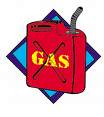
Gas cans should always be placed on the ground when filling. Never fill any portable container (regardless of material) while it is inside your car or pickup bed. Do you know why?
An approved gasoline container also dissipates static electricity, as long as it is placed on the pavement before filling begins. Leave the can in the trunk or pickup box, however, and it is a different story. A trunk liner, bed mat or bed liner insulates the vehicle from the ground and the static buildup of electricity has nowhere to go. Static buildup occurs and if it releases, the resulting spark can set off the gasoline.
The static comes from the gasoline itself. As the fuel flows through the hose and nozzle, static electricity builds up on the gasoline. This charge takes several seconds to dissipate after the gas is poured into the can. If the can is insulated from ground, the spark cannot dissipate and it builds up until discharge occurs.
According to Chevron, the condition most likely to lead to spark discharge is the filling of a metal container that is placed upon the plastic bedliner of a pickup. In their experiments, this situation resulted in the most fires. They are also quick to point out that while static discharge in metal containers caused the most fires, plastic containers are not immune.Be safe, Place the container on the ground before filling to allow static buildup to dissipate. Make sure the filler nozzle touches the rim of the filler opening to help static electricity dissipate.